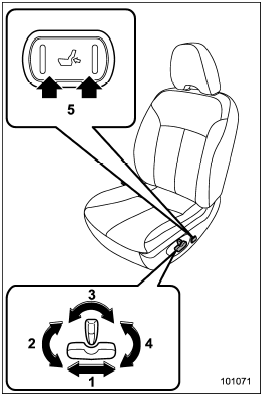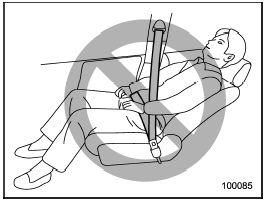Power seat (driver’s seat – if equipped)

1) Seat position forward/backward control switch
To adjust the seat forward or backward, move the control switch forward or backward. During forward/backward adjustment of the seat, you cannot adjust the seat cushion angle or seat cushion height.
2) Seat cushion angle control switch
To adjust the seat cushion angle, pull up or push down the front end of the control switch.
3) Seatback angle (reclining) control switch
To adjust the angle of the seatback, move the control switch.
4) Seat height control switch
To adjust the seat height, pull up or push down the rear end of the control switch.
5) Lumbar support control switch
To increase lumbar support, push the front side of the switch. To decrease lumbar support, push the rear side of the switch.


To prevent the passenger from sliding under the seatbelt in the event of a collision, always put the seatback in the upright position while the vehicle is in motion. Also, do not place objects such as cushions between the passenger and the seatback. If you do so, the risk of sliding under the lap belt and of the lap belt sliding up over the abdomen will increase, and both can result in serious internal injury or death.
See also:
Checking the fluid level
WARNING
Never let clutch fluid contact your eyes because clutch fluid can be harmful
to your eyes. If clutch fluid gets in your eyes, immediately flush them thoroughly
with clean water. For safet ...
Type A audio set (if equipped)
Type A audio set (if equipped)
The audio set will operate only when the ignition switch is in the “Acc” or “ON” position.
• Power and sound controls
• Radio operation
• Satellite radio operation ( ...
Shift lock function
The shift lock function helps prevent the improper operation of the select lever.
• The select lever cannot be operated unless the ignition switch is turned to the “ON” position and the brake pedal i ...


